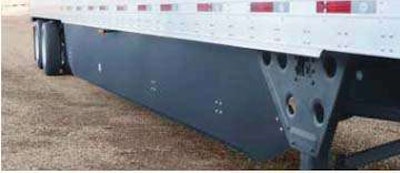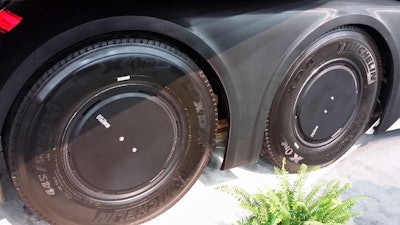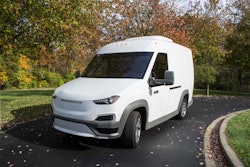

Commonly referred to as Greenhouse Gas Phase 2, most new trailers on the highway were facing a graduating mandate that would call for an efficiency improvement of 1 percent to 13 percent through 2027, and all of it would have to come through aerodynamic add-ons and, eventually, a likely redesign of the trailer itself.
We’ll eventually run out of things to hang on a trailer, right?
Mike Roeth, executive director of the North American Council for Freight Efficiency, is a friend of mine and he’s been a resource for just about every article I’ve ever written on aerodynamics.
He’s told me half-a-dozen times that there is no “one-size fits all” magic bullet when it comes to trailer aero, but the EPA was on the cusp of basically mandating one.
I’m an occasional guest on KC Phillips’ XM Radio show, Road Dog Live. A while back, before these regulations where shelved, a caller posed an interesting question: Would truck OEMs ever consider building their own trailers?
I’d never considered that possibility, and never approached a truck OEM with that question. But with the across-the-board push toward vertical integration, I think the question makes sense.
My answer to him was, and still is, no.
There is no meaningful parts commonality between the truck and trailer, so a truck OEM would have to almost completely invent the parts acquisition and assembly process, while negotiating rates for materials that they can’t scale with truck assembly. That’s an investment of millions of dollars that I just don’t think any of the North American truck giants are itching to make.
However, as the Environmental Protection Agency revisits their Phase 2 regulations for trailers – and they will revisit it – I think you may see closer collaboration between the trailer guys and the truck guys in the years ahead.
The sticking point with Phase 2’s governance of trailer efficiency is that since a trailer isn’t a self-propelled vehicle, the Truck Trailer Manufacturing Association argues it doesn’t fall under the Clean Air Act.
But at some point, the least aerodynamic thing in the combination unit must help the truck out. That’s when I think you’ll begin to see model-optimized trailer designs.
A trailer behind an International LT is going to take airflow differently than it would off a new Freightliner Cascadia.
As Roeth says, there isn’t a one-size fits all.
A bogie cover may make more sense on a 579, while a wheel covers make more sense on a new VNL. It will all depend on how the air moves under the truck.
Most of the fleets who benefit from skirts and tails already have them and they’re going to spec them going forward. Skirts and tails don’t give the same benefit for local carriers as they do long-haul on-highway fleets. Again, there are no magic bullets here.
What the EPA is chasing is an incremental gain that can only come through finessing the small gaps left over.
Rather than the EPA mandating all trailers have low rolling resistance tires, boat tails and wheel covers, it’s more logical for the OEMs to work together on trailer designs that more closely fit inside the aerodynamic footprint created by the truck.
We’ve seen such a design collaboration with the SuperTruck project, where aggressive aero and custom fit was a critical part of the program’s success. Those dividends paid off, as each participating OEM obliterated the goals set by the Department of Energy.
I don’t think there’s a lot of low-hanging aerodynamic fruit left to pick and to reach next-level efficiency goals, the pieces of the process are going to need to be engineered and designed to complement each other.












